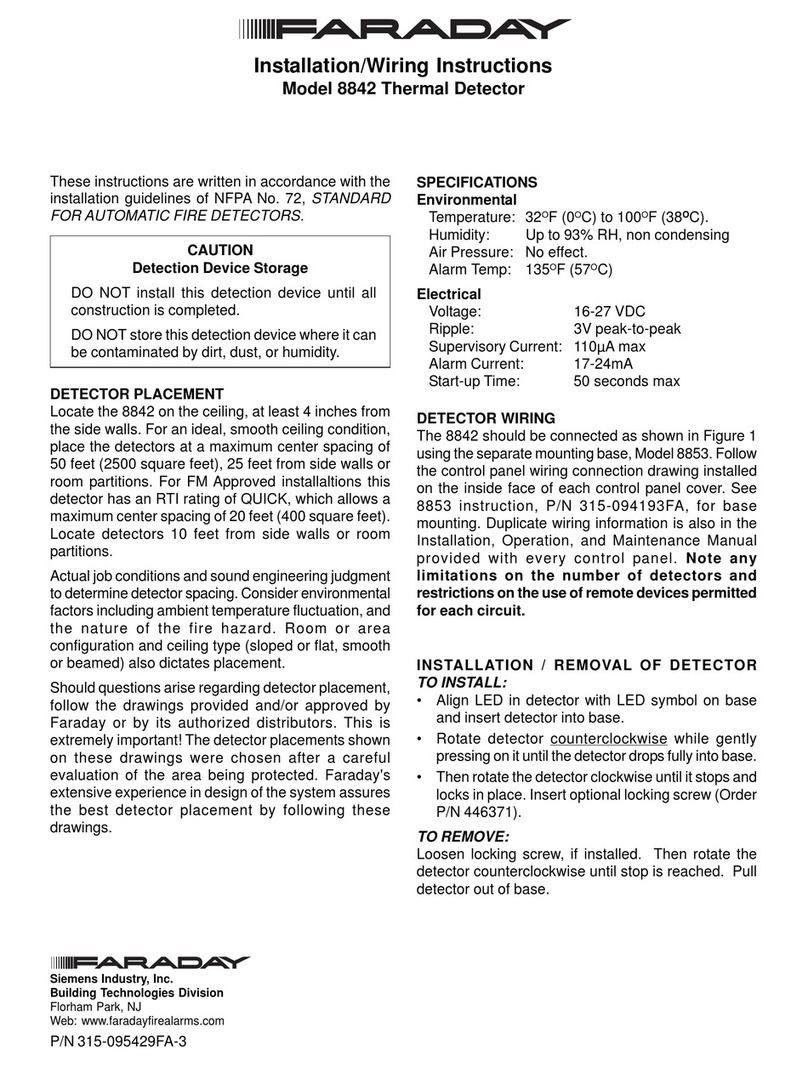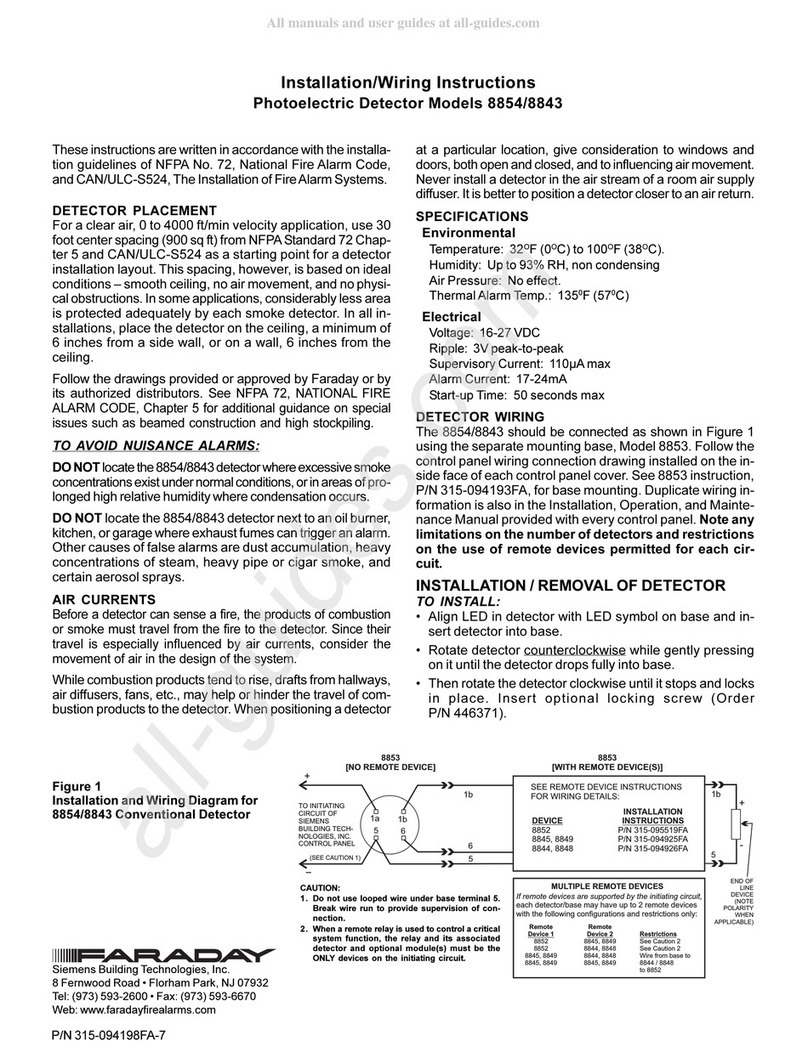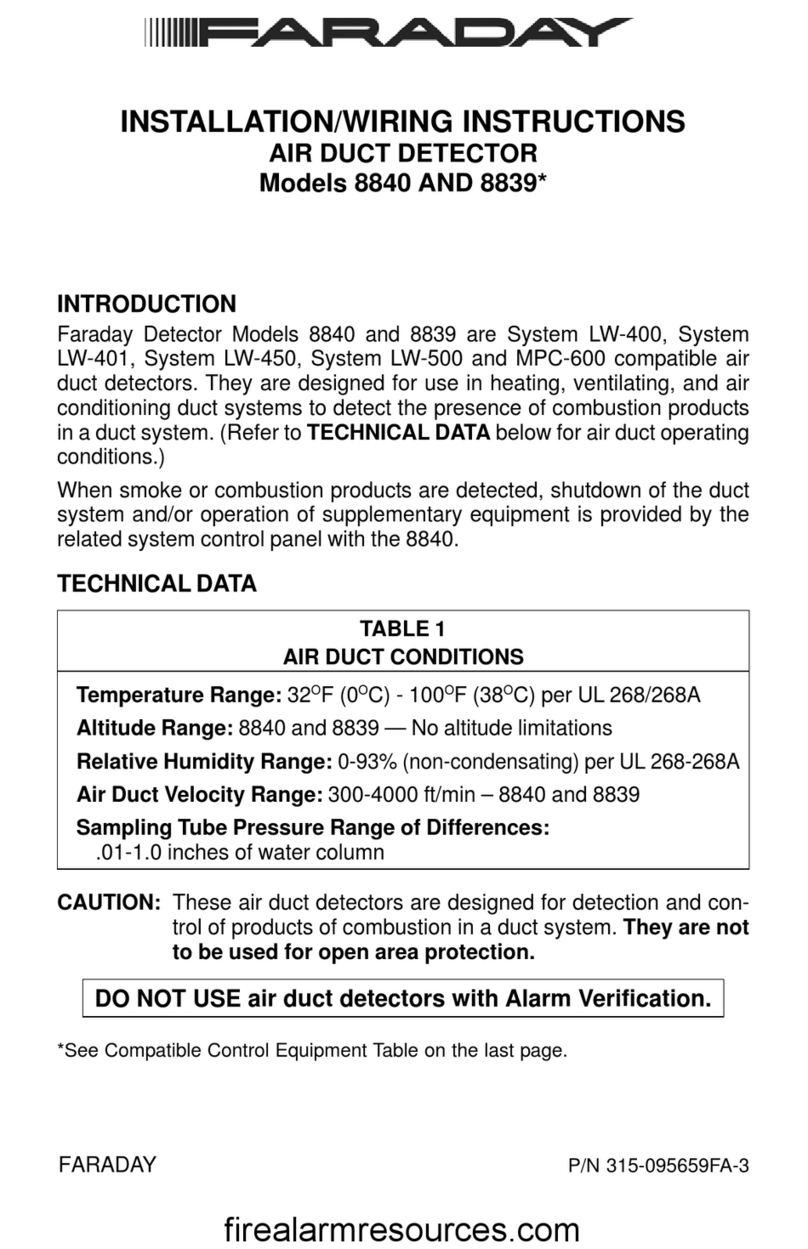
PAGE 1 OF 4 P/N 315-033290FA -3
INSTALLATION INSTRUCTIONS AND WIRING FOR
P/N 8710 ADDRESSABLE PHOTO DETECTOR AND
P/N 8713 ADDRESSABLE PHOTO/THERMAL DETECTOR AND
P/N 8712 ADDRESSABLE THERMAL DETECTOR
FARADAY
The 8710/8713/8712Addressable Detectors allow
smoke and/or heat detection on anAddressable
Device Circuit of a fire alarm control unit.A
multicolor LED indicates the condition of the
detector. This multicolor LED displays red for
alarm/output active, yellow for trouble, and green
for normal operation. The 8710/8713/8712Ad-
dressable Detectors each use one address on the
Addressable Device Circuit. It does not require
any mechanical address programming. Use the
8720 Device Programmer to program and test
each detector.
These instructions are written in accordance with
the installation guidelines of NFPA72, National Fire
Alarm Code.
CAUTION: Detector Device Storage
DO NOT install this detection device until all
construction is completed.
DO NOT store this detection device where it
can be contaminated by dirt, dust, or humidity.
DETECTOR PLACEMENT FOR 8710/8713
Although no specific spacings are set for the
detectors used for a clean air application, use 30
foot center spacing (900 sq ft) from NFPA
Standard 72, if practical, as a guide or starting
point for a detector installation layout. This
spacing, however, is based on ideal conditions -
smooth ceiling, no air movement, and no physical
obstructions. In some applications, therefore,
considerably less area is protected adequately by
each smoke detector. This is why it is mandatory to
closely follow the installation drawings. In all
installations place the detector on the ceiling, a
minimum of 6 inches from a side wall, or on a wall,
4 to 6 inches from the ceiling.
To avoid nuisance alarms
Do not locate the detectors where excessive
smoke concentrations exist under normal
conditions, or in areas of prolonged high relative
humidity where condensation occurs.
Do not locate the detectors next to an oil burner,
kitchen, or garage where exhaust fumes can
trigger an alarm. Other causes of false alarm are
dust accumulation, heavy concentrations of steam,
heavy pipe or cigar smoke, and certain aerosol sprays.
Air Currents
Before a detector can sense a fire, the products of
combustion or smoke must travel from the fire to
the detector. This travel is especially influenced by
air currents; therefore, consider air movement
when designing the system. While combustion
products tend to rise, drafts from hallways, air
diffusers, fans, etc., may help or hinder the travel
of combustion products to the detector. When
positioning a detector at a particular location, give
consideration to windows and doors, both open and
closed, to ventilating systems, both in and out of
operation, and to other factors influencing air
movement. Do not install a detector in the air
stream of a room air supply diffuser. It is better to
position a detector closer to an air return.
The distance that products of combustion or
smoke travel from a fire to the detector is not
usually the shortest linear route. Combustion
products or smoke usually rise to the ceiling, then
spread out.Average ceiling heights of 8 to 10 feet
do not abnormally affect detector response. High
ceilings, located in churches, warehouses,
auditoriums, etc., do affect detector response and
should be considered.
Special Ceiling Construction Factors
Ceiling obstructions can change the natural
movement of air and combustion products. Take
obstructions created by girders, joists, beams, air
conditioning ducts, or architectural design into
consideration when determining area protection.
Consider girders, joists, or beams 8 inches or less
in depth equivalent to a smooth ceiling in view of
the spillover effect of smoke. If obstructions are
over 8 inches in depth, movement of heated air
and smoke may be slowed by the pocket or bay
formed by the girders, joists, or beams. In this
case, reduce spacing. If obstructions exceed 18
inches in depth and are more than 8 foot centers,
treat each bay as a separate area requiring at least
one detector.

























